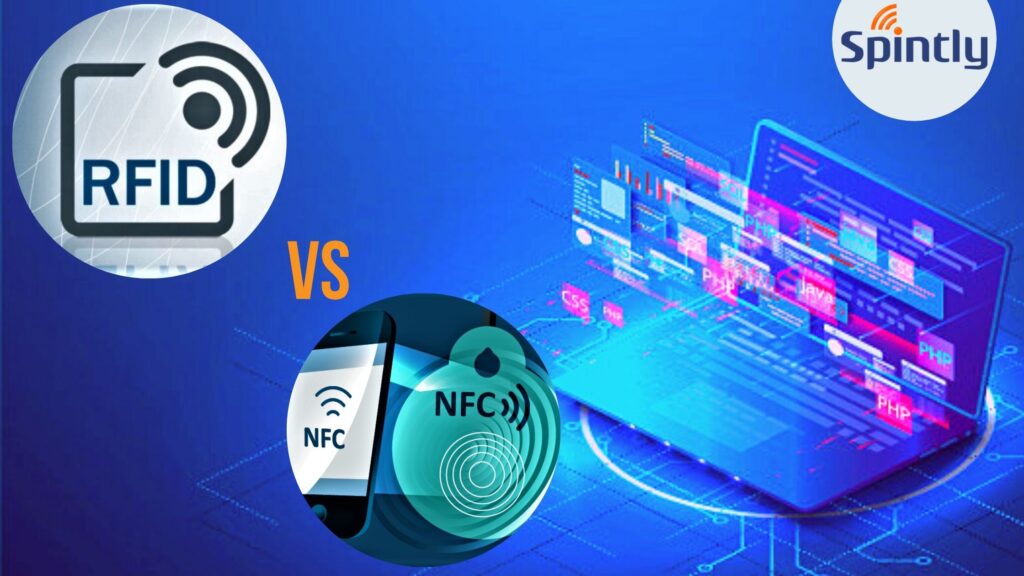RFID vs NFC Access Control Systems

What is RFID?
Radio Frequency Identification (RFID) – is a wireless technology that uses electromagnetic waves to transmit data between two devices. The RFID reader automatically detects objects labeled with RFID tags, reads the data encoded in them, and stores it for further processing. RFID process is a one-way communication wherein a reader reads the data from the tag via the antenna.
RFID is basically of two types-
Low-Frequency RFID – works well for short distances, about 10 cm between the reader and the tag
High-Frequency RFID – offers a range of up to 1 m
RFID Access Control Systems
RFID technology can be used for door access control systems, where data can be exchanged between a key card and a reader up to a few feet away. It is used in access control systems to allow only authorized personnel and with a specific access level to unlock a door.
How does it work?
Every RFID based access control system follows a similar procedure –
- RFID reader sends a radio wave to detect an RFID tag or key card nearby
- Upon detecting, the reader reads the data from the key card and sends the collected data to the access control software
- The access control software processes the data received from the receiver and signals the reader to accept or deny the entry request based upon the access level of the user
- The RFID readers are integrated with the Access Panels that make the grant or revoke decisions. The access panel control hardware opens the door based upon the instructions received from the access panels
Advantages of RFID Access Control System
- In a large organization, where access control is a major challenge, RFID readers can be customized as per need. User permissions can be given based upon the access level. If an employee leaves the organization, his/her card can be deactivated and reprogrammed for a new employee
- Since they work on electromagnetic technology, they are quite a weather-resistant and can work well in rain, snow, or any other weather condition
Drawbacks of RFID Access Control System
Despite fast and purely authenticated access, RFID access control systems have few vulnerabilities too. Some of the vulnerabilities may even lead to a security breach. The significant drawbacks of RFID access control systems are –
- RFID cards are prone to electromagnetic interference, which can arise from any magnetic device or other key cards nearby. The electromagnetic interference can be intentionally created to jam cards and readers to transmit data and block the entire access control
- The low-frequency RFID cards have the potential to be hacked because of the signals they produce. Any entity having an RFID reader can read the digitally encoded data from the key cards which cannot differentiate an authentic reader from a hostile one
- With the use of a transponder, the RFID key cards can also be cloned very easily
What is NFC?
NFC stands for Near Field Communication and is a wireless technology for a short-range that enables two devices to communicate wirelessly. Unlike RFID, an NFC device can act as both – a tag and a reader and information flow are bidirectional between two NFC devices. The range of NFC is only up to 4 inches.
The functionality of NFC is quite similar to RFID, but NFC technology is more modern and can be used in mobile access control systems. Smartphones can have smart tags activated on them, through which the phones can act as both transmitter and receiver of data.
NFC Access Control System
NFC Access Control Systems are becoming more popular these days. Due to their mobile access control, they are much preferred in contrast to RFID. Since in NFC the communication is bidirectional, there is an extra layer of security that can differentiate between a friendly reader and a fraud.
How does it work?
NFC works on the same principle as RFID. They can make use of key cards to transmit data and they also have the additional feature of using smartphones to gain access.
- When the NFC key card or a smartphone is swiped or tapped over an NFC enabled reader, a secure channel is established
- The information on the tag is transmitted to a cloud-based server where the access permission of the user is checked
- The Access Panels then decides on granting or denying the access based upon the user’s authority
Advantages of NFC Access Control System
- There’s no need for a physical key card, which can help in reducing overheads
- They are less prone to attacks as there is no need to carry a physical key card and the access can be granted through the user’s smartphone
- Since the smart tag are enabled on a smartphone it is difficult to clone a tag through a transponder. Thus, the security vulnerabilities are less
- Adding and removing users is easy and there is also no threat of stolen key cards
Drawbacks of NFC Access Control System
The only drawback when compared to RFID is – NFC devices have a shorter range so the user has to be near the reader.
Conclusion
The choice of access control depends upon you and your requirements, there’s no one correct answer. If you are an organization with valuable assets (including information, devices, etc.) and safety is your primary concern, then you might find NFC Access Control System a better fit for your organization. But if your objective is a faster and high-range access control system then RFID should be your first choice.
Spintly offers an NFC-based Access Control System to streamline your door access control with NFC Cards for a hassle-free, convenient, and wireless access experience. We believe in Amplifying the Simplicity and our main aim is to reduce the hassle of the wired access control system. For a secure experience, Spintly provides fully encrypted communication between the reader and the NFC card and can reduce the threat of cloning or copying key cards.


